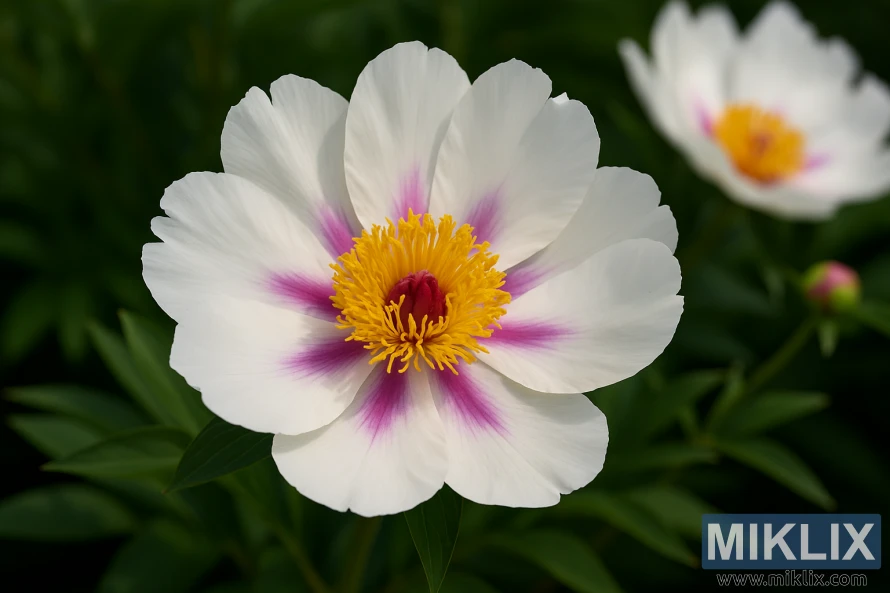Image: Close-Up of Cora Louise Intersectional Peony in Full Bloom
Published: October 19, 2025 at 8:59:25 PM UTC
Admire the beauty of the Cora Louise intersectional peony in this close-up photo, showcasing its elegant white blooms with lavender-pink flares, golden stamens, and refined garden charm.
The image presents a captivating close-up of the Cora Louise intersectional peony (Paeonia × itoh 'Cora Louise'), a uniquely beautiful and highly sought-after variety celebrated for its elegant floral form, sophisticated color contrasts, and exceptional garden performance. At the center of the composition is a single, fully opened bloom, captured in stunning detail. Its large, semi-double petals radiate outward in graceful symmetry, creating a soft, rounded silhouette that draws the eye inward to the heart of the flower.
The most striking feature of the Cora Louise peony—its exquisite coloration—is displayed to perfection. The petals are a pristine, luminous white, silky and slightly translucent, with a delicate sheen that catches the natural light. At the base of each petal, bold lavender-pink flares extend outward like watercolor brushstrokes, blending seamlessly into the surrounding white. This vivid accent adds depth and dimension to the bloom, creating a dramatic yet refined contrast that makes the flower instantly recognizable. The flares are arranged symmetrically around the center, forming a starburst-like pattern that enhances the overall harmony of the composition.
At the heart of the bloom, a vibrant cluster of golden-yellow stamens bursts outward, their fine filaments and pollen-laden anthers standing in striking contrast to the surrounding pastel tones. These stamens form a bright halo around the central carpels, which are a rich reddish-magenta color, adding a final layer of intensity to the flower’s palette. The interplay of white, lavender-pink, gold, and red is both visually captivating and botanically fascinating, embodying the complexity and beauty that make Cora Louise one of the most admired intersectional peonies.
The lighting in the image is soft and natural, likely captured in early morning or late afternoon sunlight. This gentle illumination enhances the subtle texture and veining of the petals while casting delicate shadows that emphasize the bloom’s depth and volume. The shallow depth of field isolates the central flower beautifully, rendering the background as a soft blur of rich green foliage and hints of other Cora Louise blooms. This compositional choice ensures that the viewer’s attention remains focused on the intricate details and striking coloration of the main subject while still situating it within a lush, thriving garden environment.
A secondary bloom in the distance, slightly out of focus, hints at the plant’s prolific flowering habit and adds a sense of continuity and depth to the image. A partially opened bud nearby provides a subtle narrative of growth and renewal, underscoring the timeless beauty and seasonal rhythm of the peony garden.
This photograph not only captures the visual splendor of Cora Louise but also conveys the essence of what makes intersectional peonies so extraordinary: their perfect balance of herbaceous and tree peony traits, their unique color patterns, and their ability to combine boldness with elegance. The composition, lighting, and meticulous focus all work together to highlight the flower’s refined beauty and botanical uniqueness. It is an image that celebrates the artistry of nature, capturing a fleeting moment of peak bloom in one of the most exquisite peony varieties ever cultivated.
The image is related to: The Most Beautiful Varieties of Peony Flowers to Grow in Your Garden

